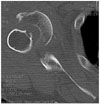Abstract
There are several methods to treat anatomic neck fracture of humerus in elderly patients. It is not easy to obtain optimal clinical or radiological results because of unstable fixaton of fractured site attributed to multifractured osteoporotic tuberosities and combined massive rotator cuff tears in these patients. These factors often lead to high failure rate of implantation. Alternative methods of treatment have been proposed to reduce complications and improve shoulder functions. Reverse shoulder prosthesis was originally designed for patients with cuff tear arthropathy. Indications for reverse shoulder arthroplasty have expanded with initial success. However, there are few reports to perform reverse shoulder prosthesis in proximal humerus fracture. We performed reverse shoulder arthroplasty in a 74-year-old man with right anatomic neck fracture of humerus and concomitant massive rotator cuff tear.
Figures and Tables
Figure 1
(A, B) Plain radiographs show displaced humeral head fracture, subacromial spur and reduced acromiohumeral interval.

Figure 2
CT scan demonstrates anteriorly displaced humeral head fragment and arthritic changes on glenoid.

Figure 3
(A, B) 3D CT reveales humerus head fracture with inferomedial displacement of fractured head fragment.

Figure 4
(A, B) MR images show full thickness rotator cuff tears with retraction and muscle atrophy.

References
1. Zyto K, Ahrengart L, Sperber A, Törnkvist H. Treatment of displaced proximal humeral fractures in elderly patients. J Bone Joint Surg Br. 1997. 79:412–417.

2. Baron JA, Karagas M, Barrett J, et al. Basic epidemiology of fractures of the upper and lower limb among Americans over 65 years of age. Epidemiology. 1996. 7:612–618.

3. Compito CA, Self EB, Bigliani LU. Arthroplasty and acute shoulder trauma. Reasons for success and failure. Clin Orthop Relat Res. 1994. (307):27–36.
4. Martin TG, Iannotti JP. Reverse total shoulder arthroplasty for acute fractures and failed management after proximal humeral fractures. Orthop Clin North Am. 2008. 39:451–457.

5. Prakash U, McGurty DW, Dent JA. Hemiarthroplasty for severe fractures of the proximal humerus. J Shoulder Elbow Surg. 2002. 11:428–430.

6. Schai P, Imhoff A, Preiss S. Comminuted humeral head fractures: a multicenter analysis. J Shoulder Elbow Surg. 1995. 4:319–330.

7. Edwards TB, Williams MD, Labriola JE, Elkousy HA, Gartsman GM, O'Connor DP. Subscapularis insufficiency and the risk of shoulder dislocation after reverse shoulder arthroplasty. J Shoulder Elbow Surg. 2009. 18:892–896.

8. Tischer T, Rose T, Imhoff AB. The reverse shoulder prosthesis for primary and secondary treatment of proximal humeral fractures: a case report. Arch Orthop Trauma Surg. 2008. 128:973–978.

9. Sirveaux F, Favard L, Oudet D, Huquet D, Walch G, Molé D. Grammont inverted total shoulder arthroplasty in the treatment of glenohumeral osteoarthritis with massive rupture of the cuff. Results of a multicentre study of 80 shoulders. J Bone Joint Surg Br. 2004. 86:388–395.




 PDF
PDF ePub
ePub Citation
Citation Print
Print




 XML Download
XML Download